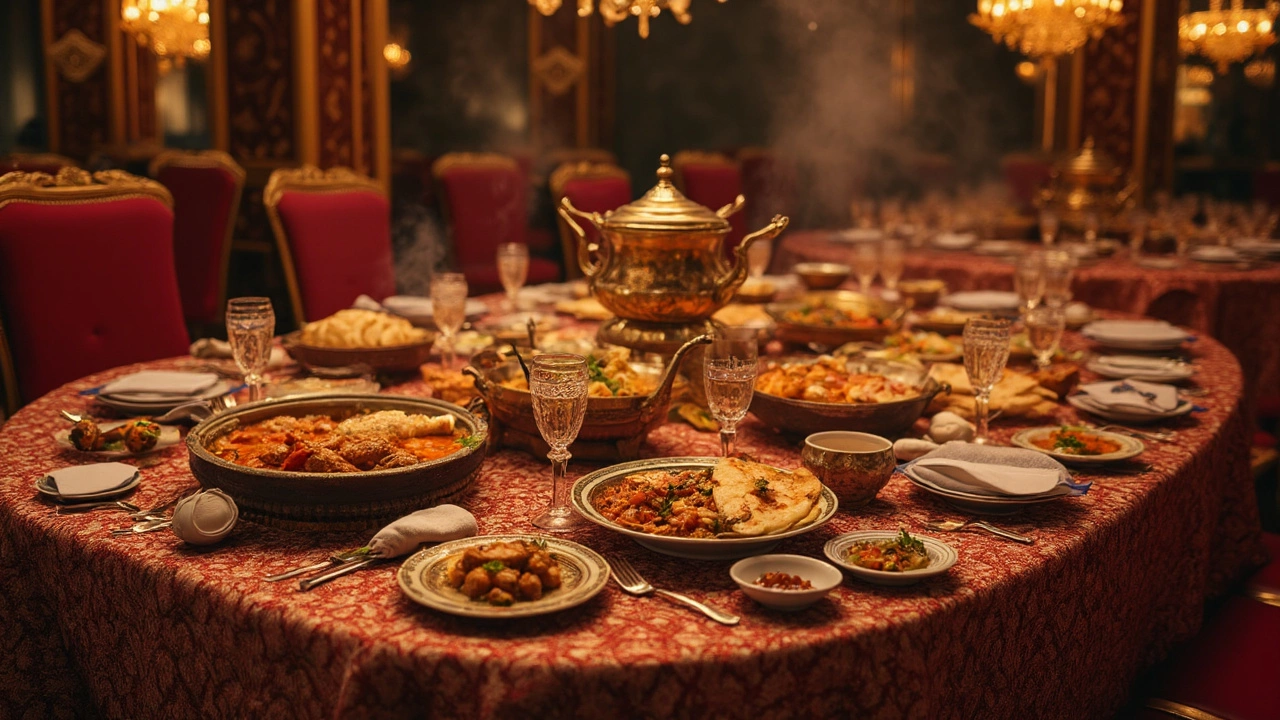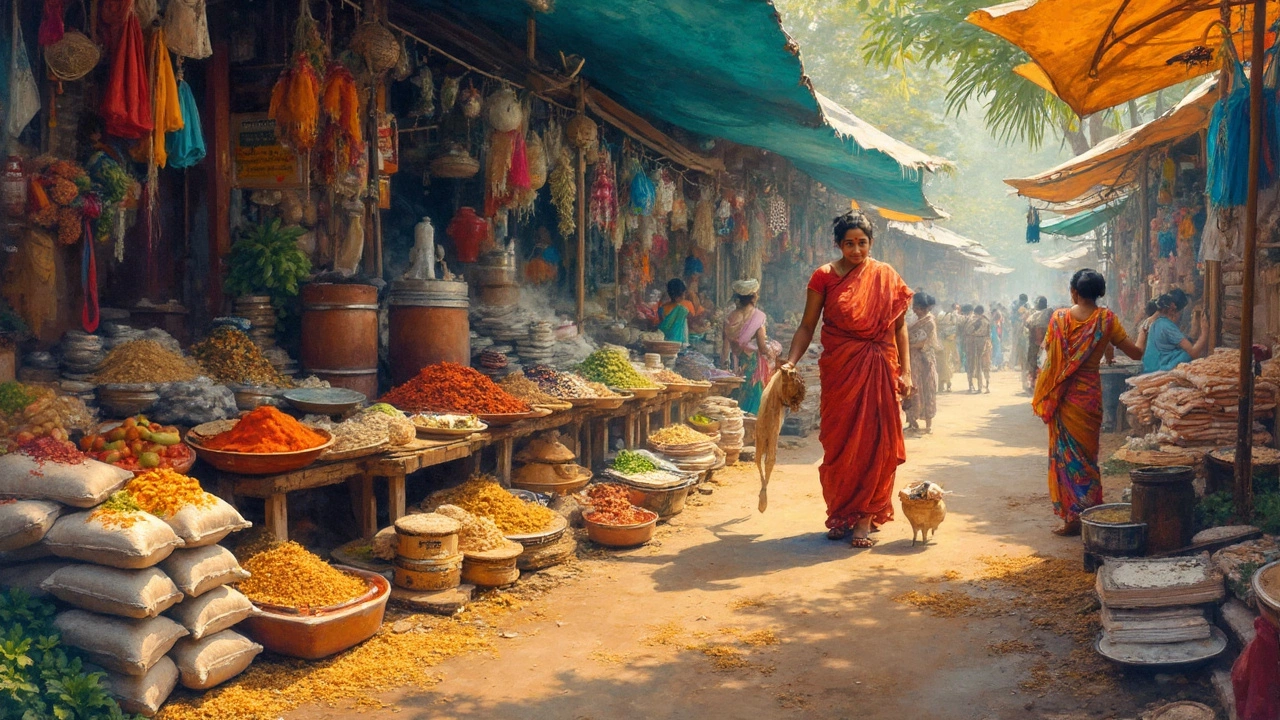Choosing between South Indian and North Indian food can feel like picking a favorite child, especially if your taste buds delight in every flavorful bite of Indian cuisine. Both regions offer distinct tastes and eating experiences that can make one’s culinary journey unforgettable.
Let’s kick off with the staples—South Indian food often embraces rice, coconut, and a variety of spices that create tangy and spicy dishes. Think of dosas, idlis, and sambar; they provide comfort and warmth, serving as the culinary heart in this region. On the other hand, North Indian cuisine tends to lean on wheat, lentils, and dairy, which manifest into rich, creamy dishes like butter chicken and paneer tikka.
- Introduction to Indian Cuisine
- Staple Ingredients
- Signature Dishes
- Cooking Techniques
- Taste and Flavor Profiles
- Conclusion: Finding Your Preference
Introduction to Indian Cuisine
India's culinary landscape is as diverse as its culture and traditions. With a rich history that spans thousands of years, each region has its own unique flavors and cooking techniques, offering a gastronomic experience that caters to every palate.
Understanding the Diversity
At a glance, Indian cuisine can be split into two primary categories: South Indian and North Indian. While both share a common love for spices, they're distinct in their ingredients and recipes. South Indian dishes typically revolve around rice and coconut, while North Indian staples lean towards wheat-based items like rotis and purees.
Cultural and Historical Influences
The historical roots of Indian food can be traced back to various empires and invasions, each leaving a mark on the region's food culture. For example, the Mughals introduced rich, aromatic gravies and mild, creamy curries in the North, a heritage still celebrated in dishes like Biryani and Korma.
"Indian cuisine is like a vast ocean where every region offers its own unique treasure trove of flavors." - Madhur Jaffrey, celebrated culinary expert.
Spices: The Heart of Indian Cooking
The quintessential Indian taste comes primarily from its spices. Whether it's turmeric, cumin, or coriander, these vibrant ingredients are what elevate the humble legumes and grains into feasts for the senses.
North Indian cuisine, often richer and creamier, uses garam masala generously, lending dishes a signature warmth. Meanwhile, South Indian food often features tamarind and coconut, giving it a tangier edge.
Regional Cuisines' Unique Practices
What's served on the plate in Kerala may be starkly different from what's found in Punjab. For instance, Andhra Pradesh is known for its fiery curries, contrasting with the mild, aromatic dishes typical of Kashmir. This variety is a testament to the regional diversity within Indian food.
Exploration of Flavors
- South India's famous for its magical mix of spices in sambhar and rasam, often served with rice.
- North India boasts a variety of breads and dairy-based recipes like paneer butter masala and dal makhani.
Whether it's through the spicy offerings of coastal Karnataka or the rich, creamy delicacies of Lucknow, the infinite spectrum of Indian culinary traditions offers something that speaks to every food lover.
Staple Ingredients
Diving into the world of Indian cooking, the staple ingredients from South and North India lay the foundation for all those rich flavors and aromas that tickle your senses. Each region boasts a unique set of essentials that gives its dishes a distinct character.
South Indian Staples
South Indian cuisine is famous for its love affair with rice. Rice isn't just a side dish here; it’s the main act. From fluffy, steamed variants that accompany curries to fermented batter forms as dosas and idlis, rice is a constant presence. Coconut also plays a major role, often used in chutneys, curries, and as a garnish. Essential spices like mustard seeds, curry leaves, and asafetida give South Indian food its signature zing.
North Indian Staples
Over in the North, it's a different story. Wheat takes center stage and manifests through a variety of breads, like naan, roti, and parathas, each offering a different texture and flavor. Lentils are another key feature, and you'll find them in delicious dals that are ladled over bread or rice. Dairy finds its place too; think yogurt, paneer, and ghee that smoothen out spicy curries and contribute to that creamy texture.
Spice and Everything Nice
Both regions love their spices, but in different ways. South Indian dishes often have a fiery kind of heat from fresh chilies and sambar powder, while North Indian food uses a broader spectrum from garam masala with its earthy warmth to dry fenugreek leaves for fragrance.
Each ingredient—from rice to spices—tells its own story, reflecting centuries of cultural exchange and adaptation. Whether you prefer the tangy, fiery kick from the South or the rich, aromatic experience from the North, it’s these staple ingredients that make Indian cuisine a delightful puzzle of flavors waiting to be explored.
Signature Dishes
Diving into the signature dishes of each region is like opening a treasure chest of flavors and aromas. Let's start with South Indian food, where the meals are known for their fiery spices, tangy tastes, and coconut-infused everything.
South Indian Delights
Take the dosa, for example—thin, crispy, and often the size of your arm. This rice and lentil crepe is a breakfast staple, typically served with chutneys and sambar, a hearty lentil soup. Then there's idli, a fluffy, steamed rice cake that soaks up flavors like a sponge, making it an ideal companion for spicy sambar.
If you're in the mood for more, vada might catch your eye. These crispy, doughnut-shaped snacks are a deep-fried glory, perfect for dipping into coconut chutney. And of course, no introduction to South Indian cuisine would be complete without mentioning biryani. While biryani is enjoyed throughout India, the Hyderabadi version, with its layers of spices and tender meat or vegetables, holds a special place in hearts.
North Indian Specialties
Heading north, the meals take on a different character. Start with butter chicken—it's as indulgent as it sounds. This creamy, tomato-based chicken curry is rich with spices, not spicy-hot, but spicy-flavorful. Pair it with naan, the fluffy, buttery flatbread that's practically designed for scooping up sauce.
Another gem is paneer tikka, cubes of Indian cheese marinated in spices and grilled to perfection. It’s a vegetarian dream, often accompanied by mint chutney. Also, let’s not overlook the mighty chole bhature—a combination of spiced chickpeas and fried bread that’s a weekend breakfast favorite for many.
Then there's an array of dals (lentils), every region and household boasting its own version. Dal Makhani, with its velvety texture and rich flavor, is a must-try, especially for those looking to discover the comforting side of North Indian cuisine.
Indian cuisine is a vast and diverse field, each dish reflecting the community it's rooted in. Whether you're stirring a pot of fiery sambar in the south or simmering butter chicken in the north, the core of Indian food lies in its ability to bring people together over a shared love of delicious eats.

Cooking Techniques
When it comes to South Indian food and North Indian cuisine, distinct cooking techniques play a pivotal role in delivering those unforgettable flavors.
South Indian Cooking Techniques
South Indian cooking relies heavily on steaming, making it one of the healthier cooking styles out there. Dishes like idlis and puttu are prepared by steaming, locking in nutrients and creating a soft texture. Fermentation is another widely used method, giving foods like dosa and idlis their unique tangy flavor. These techniques are perfect for those who prefer light and moist meals packed with subtle complex flavors.
Another staple is the 'tempering' technique, where mustard seeds, curry leaves, and dried red chilies are quickly sautéed in oil or clarified butter (ghee) to add a punch to many dishes, from sambars to chutneys.
North Indian Cooking Techniques
In contrast, North Indian cuisine is all about rich and robust flavors, often achieved through roasting and slow-cooking. Tandoori, a clay oven cooking method, imparts a distinctive smoky flavor that's hard to replicate. Think tandoori chicken and naan, each carrying the intense aroma from being flame-kissed inside the tandoor.
North Indian recipes also commonly employ marination—typically involving a mix of yogurt and spices, giving meat and paneer an aromatic tenderness. Braising is another technique that is cherished, particularly for curries, where ingredients are first browned with spices and then slowly simmered, allowing the flavors to meld beautifully.
Common Ingredients in Cooking Techniques
| Ingredient | Preparation Technique |
|---|---|
| Rice | Steaming, Fermentation |
| Wheat | Tandoori, Baking |
| Lentils | Tempering, Stewing |
| Spices | Braising, Tempering |
These techniques showcase how diverse the culinary practices can be between the two regions, each catering to different palates and often using the same base ingredients to create unique dishes. Whether your taste leans towards the spicy kick of South Indian or the creamy richness of North Indian, understanding these techniques can help you appreciate each region's unique culinary art.
Taste and Flavor Profiles
When diving into the delicious world of South Indian food and North Indian cuisine, understanding their taste and flavor profiles is essential. These profiles are as diverse and colorful as the regions they originate from.
South Indian Delights
South Indian fare is known for its use of tangy, spicy, and slightly acidic flavors. A significant part of this palate comes from ingredients like tamarind, curry leaves, mustard seeds, and coconut. Dishes often feature a spicy kick balanced by the creamy sweetness of coconut. The dosa, for instance, is a prime example—crisp, slightly tangy, and a perfect vehicle for spicy or coconut-based chutneys.
North Indian Taste Sensations
In contrast, North Indian cuisine showcases a richer, more robust flavor profile. It's all about cream, butter, and aromatic spices like cumin, cardamom, and garam masala. The resulting flavors are often savory, creamy, and mildly spicy to suit its heartwarming dishes like butter chicken and dal makhani. If you love bread, the variety of naan and parathas in North India, accompanied by their thick gravies, is a treat!
A Quick Comparison
Here's a snapshot of how these regions differ in taste:
| Region | Key Flavors | Main Ingredients |
|---|---|---|
| South India | Tangy, Spicy, Sour | Rice, Coconut, Tamarind |
| North India | Rich, Creamy, Savory | Wheat, Dairy, Lentils |
Whether you prefer the spice-laden dishes of South India or the creamy comfort of North Indian meals, both bring something unique to your plate. Next time you're dining out or cooking at home, why not try both and see which one hits the spot?
Conclusion: Finding Your Preference
Deciding whether South Indian food or North Indian cuisine is better ultimately hinges on your personal tastes. Are you the type who craves the creamy textures and spicy gravies that define North Indian fare? Or do you find yourself longing for the tangy, coconut-infused flavors of the South?
When it comes to spices, North Indian dishes often feature a robust masala mix, highlighted by generous use of ghee (clarified butter) and cream, making the dishes rich and indulgent. In contrast, the South tends to use spices to deliver a punch of heat, with dishes often layered with tempered mustard seeds and curry leaves.
It's worth noting that each region has its claim to fame. North India dazzles with its tandoori creations, while the South wins hearts with its breakfast offerings and coastal seafood delights. The point is, each side has such variety and depth, it's hard to label one as superior.
Try Both to Decide
We suggest diving headfirst into both culinary traditions. Create a homemade dosa on one day and a bowl of creamy dal makhani the next. Restaurants specializing in these cuisines often offer rich menus—you’ll be spoilt for choice.
Sometimes, the best choice is no choice at all. Embrace both regions’ offerings and watch as each bite becomes a culinary adventure. After all, exploring Indian culinary landscapes might be just the passport to the best of both worlds.
